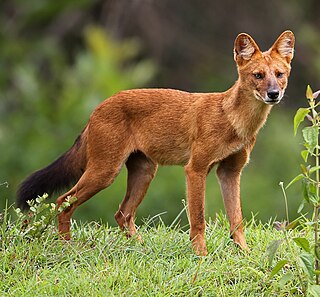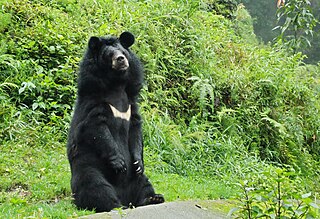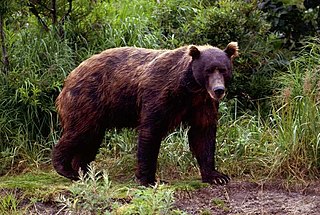 W
WThe banded palm civet, also called banded civet, is a viverrid native to Myanmar, Peninsular Malaysia, peninsular Thailand and the Sunda Islands of Sipura, Sumatra and Borneo. It is listed as Near Threatened on the IUCN Red List because of its large geographic and elevation range and tolerance to some habitat disturbance.
 W
WThe Tibetan bear or Tibetan blue bear is a subspecies of the brown bear found in the eastern Tibetan Plateau. It is also known as the Himalayan blue bear, Himalayan snow bear, Tibetan brown bear, or the horse bear. In Tibetan, it is known as Dom gyamuk.
 W
WThe binturong, also known as bearcat, is a viverrid native to South and Southeast Asia. It is uncommon in much of its range, and has been assessed as Vulnerable on the IUCN Red List because of a declining population trend that is estimated at more than 30% since the mid 1980s.
 W
WThe large-spotted civet is a viverrid native to Southeast Asia that is listed as Endangered on the IUCN Red List.
 W
WThe dhole is a canid native to Central, South, East, and Southeast Asia. Other English names for the species include Asian wild dog, Asiatic wild dog, Indian wild dog, whistling dog, red dog, and mountain wolf. It is genetically close to species within the genus Canis, but distinct in several anatomical aspects: its skull is convex rather than concave in profile, it lacks a third lower molar and the upper molars sport only a single cusp as opposed to between two and four. During the Pleistocene, the dhole ranged throughout Asia, Europe, and North America but became restricted to its historical range 12,000–18,000 years ago.
 W
WThe dhole is a canid native to Central, South, East, and Southeast Asia. Other English names for the species include Asian wild dog, Asiatic wild dog, Indian wild dog, whistling dog, red dog, and mountain wolf. It is genetically close to species within the genus Canis, but distinct in several anatomical aspects: its skull is convex rather than concave in profile, it lacks a third lower molar and the upper molars sport only a single cusp as opposed to between two and four. During the Pleistocene, the dhole ranged throughout Asia, Europe, and North America but became restricted to its historical range 12,000–18,000 years ago.
 W
WThe East Siberian brown bear (Ursus arctos collaris) is a population or subspecies of brown bear which ranges from eastern Siberia, beginning at the Yenisei river, north to the Arctic Circle, as far as Trans-Baikaliya, the Stanovoy Range, the Lena River, Kolyma and generally throughout Yakutia and the Altai Mountains. The subspecies is also present in northern Mongolia.
 W
WThe Eurasian brown bear is one of the most common subspecies of the brown bear, and is found in much of Eurasia. It is also known as the European brown bear, common brown bear, common bear, and colloquially by many other names. "The genetic diversity of present-day brown bears has been extensively studied over the years and appears to be geographically structured into five main clades based upon analysis of the mtDNA. "
 W
WThe ezo red fox is a subspecies of red fox widely distributed in Hokkaido, Sakhalin, the Kuril Islands and the surrounding islands of Japan.
 W
WThe red fox is the largest of the true foxes and one of the most widely distributed members of the order Carnivora, being present across the entire Northern Hemisphere including most of North America, Europe and Asia, plus parts of North Africa. It is listed as least concern by the IUCN. Its range has increased alongside human expansion, having been introduced to Australia, where it is considered harmful to native mammals and bird populations. Due to its presence in Australia, it is included on the list of the "world's 100 worst invasive species".
 W
WThe silver fox is a melanistic form of the red fox. Silver foxes display a great deal of pelt variation. Some are completely glossy black except for a white colouration on the tip of the tail, giving them a somewhat silvery appearance. Some silver foxes are bluish-grey, and some may have a cinereous colour on the sides.
 W
WThe Gobi bear (Ursus arctos gobiensis; known in Mongolian as the Mazaalai, is a subspecies of the brown bear that is found in the Gobi Desert of Mongolia. It is listed as critically endangered by the Mongolian Redbook of Endangered Species and by the Zoological Society of London. The population included only around 30 adults in 2009, and is separated by enough distance from other brown bear populations to achieve reproductive isolation.
 W
WThe Himalayan black bear is a subspecies of the Asian black bear found in the Himalayas of India, Bhutan, Nepal, China and Pakistan.
 W
WThe Himalayan brown bear, also known as the Himalayan red bear, isabelline bear or Dzu-Teh, is a subspecies of the brown bear and is known from northern Afghanistan, northern Pakistan, northern India, west China and Nepal. It is the largest mammal in the region, males reaching up to 2.2 m (7 ft) long, while females are a little smaller. The bears are omnivorous and hibernate in dens during the winter. While the brown bear as a species is classified as Least Concern by the IUCN, this subspecies is highly endangered and populations are dwindling. It is Endangered in the Himalayas and Critically Endangered in Hindu Kush.
 W
WThe Himalayan wolf is a canine of debated taxonomy. It is distinguished by its genetic markers, with mitochondrial DNA indicating that it is genetically basal to the Holarctic grey wolf, genetically the same wolf as the Tibetan wolf, and has an association with the African golden wolf. No striking morphological differences are seen between the wolves from the Himalayas and those from Tibet. The Himalayan wolf lineage can be found living in the Himalayas and the Tibetan Plateau predominantly above 4,000 m in elevation because it has adapted to a low-oxygen environment, compared with other wolves that are found only at lower elevations.
 W
WHose's palm civet, also known as Hose's civet, is a viverrid species endemic to the island of Borneo. It is listed on the IUCN Red List as Vulnerable because of an ongoing population decline, estimated to be more than 30% over the last three generations and suspected to be more than 30% in the next three generations due to declines in population inferred from habitat destruction and degradation.
 W
WThe striped hyena is a species of hyena native to North and East Africa, the Middle East, the Caucasus, Central Asia and the Indian subcontinent. It is listed by the IUCN as near-threatened, as the global population is estimated to be under 10,000 mature individuals which continues to experience deliberate and incidental persecution along with a decrease in its prey base such that it may come close to meeting a continuing decline of 10% over the next three generations. It is also the national animal of Lebanon.
 W
WThe golden jackal is a wolf-like canid that is native to Southeast Europe, Southwest Asia, South Asia, and regions of Southeast Asia. Compared with the Arabian wolf, which is the smallest of the gray wolves, the jackal is smaller and possesses shorter legs, a shorter tail, a more elongated torso, a less-prominent forehead, and a narrower and more pointed muzzle. The golden jackal's coat can vary in color from a pale creamy yellow in summer to a dark tawny beige in winter. It is listed as 'least concern' on the IUCN Red List due to its widespread distribution and high density in areas with plenty of available food and optimum shelter.
 W
WThe Japanese river otter (Japanese: ニホンカワウソ is an extinct variety of otter formerly widespread in Japan. Dating back to the 1880s, it was even seen in Tokyo. The population suddenly shrank in the 1930s, and the mammal nearly vanished. Since then, it has only been spotted several times, in 1964 in the Seto Inland Sea, and in the Uwa Sea in 1972 and 1973. The last official sighting was in the southern part of Kōchi Prefecture in 1979, when it was photographed in the mouth of the Shinjo River in Susaki. It was subsequently classified as a "Critically Endangered" species on the Japanese Red List. On August 28, 2012, the Japanese river otter was officially declared extinct by the Ministry of the Environment. It is the official animal symbol of Ehime Prefecture. In February 2017, a wild otter was caught on camera on Tsushima Island, Nagasaki Prefecture. However, it is not known whether the observed otter was a Japanese river otter.
 W
WThe Kamchatka brown bear, also known as the "Far Eastern brown bear", or in Russian: Камчатский бурый медведь, is a subspecies of brown bear native to the Anadyrsky District, the Kamchatka Peninsula, Karaginskiy Island, the Kuril Islands, the coastal strip west of the Sea of Okhotsk southward to the Stanovoy Range, and the Shantar Islands in the Far East. Outside the former Soviet Union, the subspecies occurs in Saint Lawrence Island in the Bering sea. It is closely related to one clade of brown bears in Alaska and northwest North America, and is thought to be the ancestor of the Kodiak bear.
 W
WThe spotted linsang is a linsang, a tree-dwelling carnivorous mammal, native to much of Southeast Asia. It is widely, though usually sparsely, recorded, and listed as Least Concern on the IUCN Red List.
 W
WThe ruddy mongoose is a mongoose species native to hill forests in India and Sri Lanka. This mongoose, along with the striped-neck and Indian grey mongeese, are the only mongoose species endemic to India and Sri Lanka. The ruddy mongoose is very closely related to Indian grey mongoose, but distinguished by its slightly larger size and black-tipped tail extending for 2 to 3 inches at the distal end. There are two subspecies of this mongoose, H. smithii smithii in India, and H. smithii zeylanicus in Sri Lanka.
 W
WThe otter civet is a semiaquatic viverrid native to Thailand, Malaysia, Indonesia and Brunei. It is listed as Endangered because of a serious ongoing population decline, estimated to be more than 50% over the past three generations, inferred from direct habitat destruction, and indirect inferred declines due to pollutants.
 W
WThe Eurasian otter, also known as the European otter, Eurasian river otter, common otter, and Old World otter, is a semiaquatic mammal native to Eurasia. The most widely distributed member of the otter subfamily (Lutrinae) of the weasel family (Mustelidae), it is found in the waterways and coasts of Europe, many parts of Asia, and parts of northern Africa. The Eurasian otter has a diet mainly of fish, and is strongly territorial. It is endangered in some parts of its range, but is recovering in others.
 W
WThe sea otter is a marine mammal native to the coasts of the northern and eastern North Pacific Ocean. Adult sea otters typically weigh between 14 and 45 kg, making them the heaviest members of the weasel family, but among the smallest marine mammals. Unlike most marine mammals, the sea otter's primary form of insulation is an exceptionally thick coat of fur, the densest in the animal kingdom. Although it can walk on land, the sea otter is capable of living exclusively in the ocean.
 W
WThe smooth-coated otter is an otter species occurring in most of the Indian subcontinent and Southeast Asia, with a disjunct population in Iraq. It is listed as Vulnerable on the IUCN Red List since 1996 and is threatened by habitat loss, pollution of wetlands and poaching for the illegal wildlife trade. As its name indicates, its fur is smooth and shorter than that of other otter species.
 W
WOwston's palm civet is a civet native to Vietnam, Laos and southern China. It is listed as Endangered by IUCN because of an ongoing population decline, estimated to be more than 50% over the last three generations, inferred from over-exploitation, habitat destruction and degradation.
 W
WThe polar bear is a hypercarnivorous bear whose native range lies largely within the Arctic Circle, encompassing the Arctic Ocean, its surrounding seas and surrounding land masses. It is the largest extant bear species, as well as the largest extant predatory carnivore. A boar weighs around 350–700 kg (770–1,540 lb), while a sow is about half that size. Although it is the sister species of the brown bear, it has evolved to occupy a narrower ecological niche, with many body characteristics adapted for cold temperatures, for moving across snow, ice and open water, and for hunting seals, which make up most of its diet. Although most polar bears are born on land, they spend most of their time on the sea ice. Their scientific name means "maritime bear" and derives from this fact. Polar bears hunt their preferred food of seals from the edge of sea ice, often living off fat reserves when no sea ice is present. Because of their dependence on the sea ice, polar bears are classified as marine mammals.
 W
WThe marbled polecat is a small mammal belonging to the monotypic genus Vormela within the mustelid subfamily Ictonychinae. Vormela is from the German word Würmlein, which means "little worm". The specific name peregusna comes from perehuznya (перегузня), which is Ukrainian for "polecat". Marbled polecats are generally found in the drier areas and grasslands of southeastern Europe to western China. Like other members of Ictonychinae, it can emit a strong-smelling secretion from anal sacs under the tail when threatened.
 W
WThe small Indian civet is a civet native to South and Southeast Asia. It is listed as Least Concern on the IUCN Red List because of its widespread distribution, widespread habitat use and healthy populations living in agricultural and secondary landscapes of many range states.
 W
WThe Sulawesi palm civet, also known as Sulawesi civet, musang and brown palm civet is a little-known palm civet endemic to Sulawesi. It is listed as Vulnerable on the IUCN Red List due to population decline estimated to have been more than 30% over the last three generations inferred from habitat destruction and degradation.
 W
WThe Syrian brown bear is a relatively small subspecies of brown bear native to the Middle East.
 W
WThe Tian Shan dhole, also known as the Siberian dhole, western Asiatic dhole, or northern dhole is a subspecies of dhole native to the Altai and Tian Shan mountain ranges, and possibly Pamir and Kashmir.
 W
WThe brown bear is a large bear species found across Eurasia and North America. In North America, the populations of brown bears are called grizzly bears. It is one of the largest living terrestrial members of the order Carnivora, rivaled in size only by its closest relative, the polar bear, which is much less variable in size and slightly bigger on average. The brown bear's range includes parts of Russia, Central Asia, China, Canada, the United States, Hokkaido, Scandinavia, the Balkans, the Picos de Europa and the Carpathian region, especially Romania, Bulgaria, Iran, Anatolia and the Caucasus. The brown bear is recognized as a national and state animal in several European countries.
 W
WThe Ussuri brown bear, also known as the Ezo brown bear and the black grizzly bear, is a subspecies of the brown bear or population of the Eurasian brown bear. One of the largest brown bears, a very large Ussuri brown bear may approach the Kodiak bear in size. The Ussuri is not the same subspecies as the grizzly bear.
 W
WThe least weasel, little weasel, common weasel, or simply weasel in the UK and much of the world, is the smallest member of the genus Mustela, family Mustelidae and order Carnivora. It is native to Eurasia, North America and North Africa, and has been introduced to New Zealand, Malta, Crete, Bermuda, Madeira Island, the Azores, the Canary Islands, São Tomé, the Falkland Islands, Argentina and Chile. It is classified as least concern by the IUCN, due to its wide distribution and large population throughout the Northern Hemisphere.
 W
WThe wolf, also known as the gray wolf or grey wolf, is a large canine native to Eurasia and North America. More than thirty subspecies of Canis lupus have been recognized, and gray wolves, as colloquially understood, comprise non-domestic/feral subspecies. The wolf is the largest extant member of Canidae, males averaging 40 kg (88 lb) and females 37 kg (82 lb). Wolves measure 105–160 cm (41–63 in) in length and 80–85 cm (31–33 in) at shoulder height. The wolf is also distinguished from other Canis species by its less pointed ears and muzzle, as well as a shorter torso and a longer tail. The wolf is nonetheless related closely enough to smaller Canis species, such as the coyote and the golden jackal, to produce fertile hybrids with them. The banded fur of a wolf is usually mottled white, brown, gray, and black, although subspecies in the arctic region may be nearly all white.